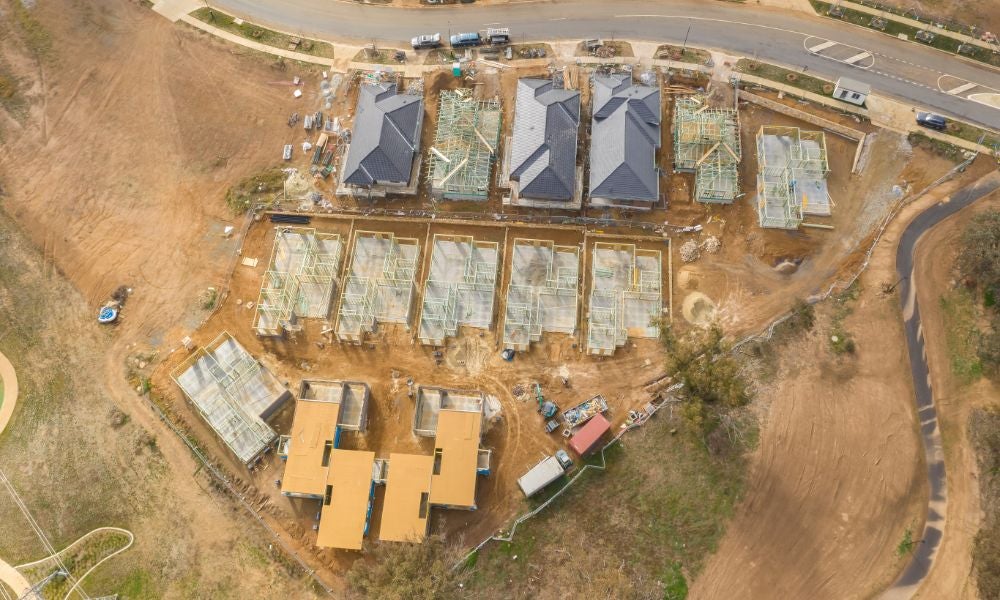Fixing the construction industry house of cards
Australia's homebuilding crisis demands urgent reforms to protect consumers from financial loss, writes UNSW Business School's Bradley Hastings and Peter Swan
If there is an industry Australia needs confidence in right now, it’s the residential construction sector. Yet, at a time of unprecedented need to build, construction companies are collapsing like houses of cards, leaving consumers with lost deposits and half-finished homes.
For consumers, embarking on building or renovating a home represents a large financial commitment, however when compared to other major investments that Australians will make in their lifetime, protection for their funds is limited. Indeed, builders can – and do – spend consumer deposits in any way that they please.
This article argues for the introduction of a regulatory mechanism that ring-fences consumer funds as a necessary element to restore confidence in the sector, improve the financial viability of homebuilders, and give hope that national home-building targets can be met.

Something’s broken in the residential construction sector
Australia needs to build new homes. Driving demand is high immigration, with 2023 seeing a net migration of 518,000 immigrants, coupled with an ongoing trend for fewer habitants per home. On the supply side, building commencements are in decline, with 2024 data for new dwelling commencements at 10-year lows. Overall, the ratio of new population to new dwelling approval is the worst since data began to be recorded in 1984.
Despite this urgent need to build, residential construction companies are going into liquidation at an alarming rate. According to ASIC data, in the 2023-2024 financial year 2,832 construction companies went into insolvency, representing the greatest proportion of company collapses, and a problem that is trending worse, not better. These are not small nor newly established companies either. Several industry-revered names have gone under, including Clough Group, Probuild, and Porter Davis Homes.
Covid disruptions, including skilled labour shortages and rising raw material costs, are often blamed for the high level of insolvencies. However, as the economy begins to settle down, the building industry doesn’t appear to be following suit. Warning signs have been unheeded, with a 2022 review by the Reserve Bank of Australia identifying financial pressures across the sector. This same report predicted that insolvency levels would increase – exactly what has transpired since – and the potential for the financial stress of these insolvencies to spread to consumers and the wider construction supply chain.
Read more: Alan Kohler: market distortions are fuelling Australia’s housing crisis
Going ‘under the hood’, Australia’s homebuilding industry is characterised by low profit margins and fixed price contracts, meaning that there is little headroom nor mechanism for builders to absorb pressures such as rises in material costs and shortages of labour. Indeed, rising labour and/or material prices are a common tune when companies have entered into insolvency.
This means that many homebuilders have been operating at negative cashflows, where suppliers don’t get paid, and projects are left unfinished. According to the Association of Professional Builders,” the construction industry is broken and will continue to fail until it is fixed”, a call that has been echoed by investigative journalists and suppliers to the sector.
Consumers left ‘carrying the can’
When a residential homebuilder goes bust, consumers become unsecured creditors and are at the bottom of the food chain after a lengthy insolvency process. For many consumers, the great Australian dream of building or renovating a home has turned into a nightmare. News is replete with stories of lost consumer deposits and half-finished homes.

The only available remedy is builder’s insurance, with most states (Tasmania being an exception) legislating that builders take out insurance that covers an insolvency event. However, such protection has bounds: claims cannot be initiated until five weeks after insolvency, policy limits vary between states, and in some cases, are limited to 20 per cent of the value of the build. In the case of Porter Davis Homes, this insurance wasn’t taken out in the first place, leaving consumers completely in the lurch.
The fallout does not stop at consumers; subcontractors also join consumers on the unsecured creditors' lists. Often small or family-run businesses become unsecured creditors needing to cover the cost of their materials and staff if they want to continue to trade.
The asymmetric risk for consumers, compared to other largest investments
Embarking on building or renovating a home is one of the largest investments an Australian will make. Yet, in comparison to other large investments, such as superannuation, banking deposits, or payments to professional services firms, there is little regulation in the construction sector regarding how consumer funds are utilised and protected.
Read more: The great construction company collapse: when your builder goes bust
Across financial services, regulations protect consumer funds in the event that one of these institutions collapses. Consider consumer payments for legal services; here consumer funds must be held in a client account and only used for their intended purpose. Contrastingly, when a homeowner places a deposit with a builder, this money can be spent for any purpose. In some cases, there have been stories of builders on luxurious holidays at the same time as homes go unfinished. More often, given the cash flow pressures across the industry, consumer deposits from one project are used to complete prior commitments.
It seems nonsensical that consumer deposits can be used for purposes outside which they are intended, however builder accounts are opaque and it is very hard to know where the money goes and little incentive or need for homebuilders to spend money on the project for which it is intended.
One remedy for homebuilders’ tight cash flows is to delay payments to suppliers. Another remedy is to take on more projects because these new deposits will increase cash flow in the short term. Paradoxically, this means that troubled builders put more consumers at risk, thus becoming a classic Ponzi scheme – until it falls over.

More money does not fix a broken system
The present political solution to Australia’s home-building challenge is to throw a wall of money at it. Federally, there is the 1.2 million new homes target backed by the $10 billion Housing Australia Future Fund, a $3 billion New Homes Bonus, and a $2 billion Social Housing Accelerator. States are chipping in, too; one example is the New South Wales Government’s $2.2 billion commitment to new infrastructure and unlocking land – all with the view to promote new dwellings.
The NSW Premier, Chris Minns, says his state is currently unable to meet its target of 75,000 new homes annually. There is very little evidence that throwing money at the problem has yet resulted in a single new home being built, but plenty of historical evidence that such large-scale stimulus will increase inflation – exactly the pressure that the residential construction sector has proved it cannot cope with.
A solution – protecting consumer deposits
Against a backdrop of stories of consumers being left in the lurch, it is hard to see confidence returning unless the industry takes a new approach. Financial services firms already provide a template for ring-fencing consumer funds and ensuring that money is spent for its intended purpose. Extending this protection to the residential construction sector would require setting up project accounts, where consumer funds reside until they are drawn down by builders and subcontractors and the work is completed to standard. In the event that the builder goes bust, this money remains in place to pay subcontractors and continue the build. A side benefit of this approach is that it may improve the robustness of the construction industry, providing homebuilders with a motive to ensure that each project stands on sound financial footing.
Subscribe to BusinessThink for the latest research, analysis and insights from UNSW Business School
Stories of consumers losing their deposits are not what is needed right now. Fragile supply chains where subcontractors are unsure if they will get paid do not bode well for the sector either. The idea of ring-fenced accounts is not new. It’s time for governments to fix what is broken, chiefly how money flows through the industry. Doing so might be the only way to get value for money from Australian taxpayers' investment in new homes.
Dr Bradley Hastings is an Insights Associate at the UNSW Business Insights Institute and Dr Peter Swan is a Professor in the School of Banking and Finance at UNSW Business School. To learn more, watch SBS Insight: Season 2024 Episode 23 – Buildings Blocked, which features Dr Brad Hastings.
The UNSW Business Insights Institute delivers economic and business insights, research and methods to government and business. Using a program-based approach consisting of Knowledge Hubs and Research Labs, the Institute helps industry partners solve complex challenges by providing them with access to novel research insights.
